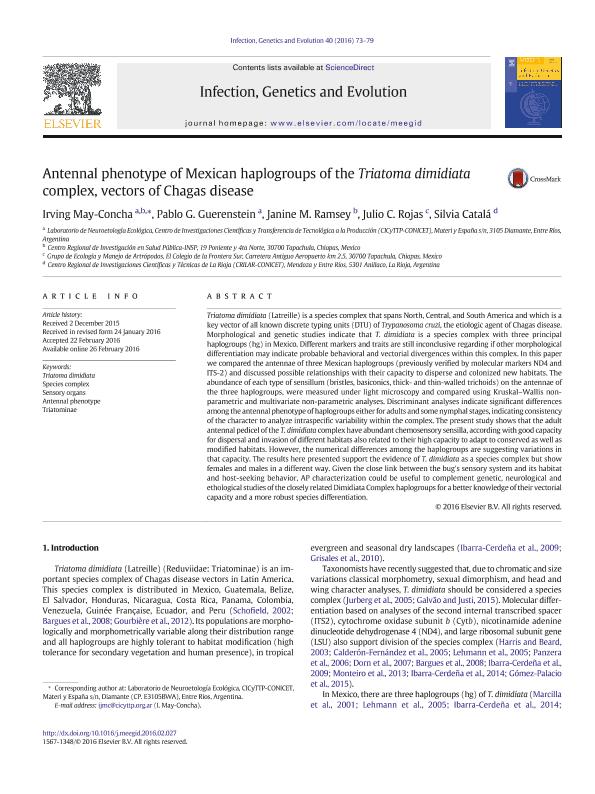Mostrar el registro sencillo del ítem
dc.contributor.author
May Concha, Irving Jesus

dc.contributor.author
Guerenstein, Pablo Gustavo

dc.contributor.author
Ramsey, Janine

dc.contributor.author
Rojas, Julio C.
dc.contributor.author
Catala, Silvia Susana

dc.date.available
2018-04-17T20:15:24Z
dc.date.issued
2016-02
dc.identifier.citation
May Concha, Irving Jesus; Guerenstein, Pablo Gustavo; Ramsey, Janine; Rojas, Julio C.; Catala, Silvia Susana; Antennal phenotype of Mexican haplogroups of the Triatoma dimidiata complex, vectors of Chagas disease; Elsevier Science; Infection, Genetics and Evolution; 40; 2-2016; 73-79
dc.identifier.issn
1567-1348
dc.identifier.uri
http://hdl.handle.net/11336/42382
dc.description.abstract
Triatoma dimidiata (Latreille) is a species complex that spans North, Central, and South America and which is a key vector of all known discrete typing units (DTU) of Trypanosoma cruzi, the etiologic agent of Chagas disease. Morphological and genetic studies indicate that T. dimidiata is a species complex with three principal haplogroups (hg) in Mexico. Different markers and traits are still inconclusive regarding if other morphological differentiation may indicate probable behavioral and vectorial divergences within this complex. In this paper we compared the antennae of three Mexican haplogroups (previously verified by molecular markers ND4 and ITS-2) and discussed possible relationships with their capacity to disperse and colonized new habitats. The abundance of each type of sensillum (bristles, basiconics, thick- and thin-walled trichoids) on the antennae of the three haplogroups, were measured under light microscopy and compared using Kruskal-Wallis non-parametric and multivariate non-parametric analyses. Discriminant analyses indicate significant differences among the antennal phenotype of haplogroups either for adults and some nymphal stages, indicating consistency of the character to analyze intraspecific variability within the complex. The present study shows that the adult antennal pedicel of the T. dimidiata complex have abundant chemosensory sensilla, according with good capacity for dispersal and invasion of different habitats also related to their high capacity to adapt to conserved as well as modified habitats. However, the numerical differences among the haplogroups are suggesting variations in that capacity. The results here presented support the evidence of T. dimidiata as a species complex but show females and males in a different way. Given the close link between the bug's sensory system and its habitat and host-seeking behavior, AP characterization could be useful to complement genetic, neurological and ethological studies of the closely related Dimidiata Complex haplogroups for a better knowledge of their vectorial capacity and a more robust species differentiation.
dc.format
application/pdf
dc.language.iso
eng
dc.publisher
Elsevier Science

dc.rights
info:eu-repo/semantics/openAccess
dc.rights.uri
https://creativecommons.org/licenses/by-nc-nd/2.5/ar/
dc.subject
ANTENNAL PHENOTYPE
dc.subject
SENSORY ORGANS
dc.subject
SPECIES COMPLEX
dc.subject
TRIATOMA DIMIDIATA
dc.subject
TRIATOMINAE
dc.subject.classification
Otras Ciencias Biológicas

dc.subject.classification
Ciencias Biológicas

dc.subject.classification
CIENCIAS NATURALES Y EXACTAS

dc.title
Antennal phenotype of Mexican haplogroups of the Triatoma dimidiata complex, vectors of Chagas disease
dc.type
info:eu-repo/semantics/article
dc.type
info:ar-repo/semantics/artículo
dc.type
info:eu-repo/semantics/publishedVersion
dc.date.updated
2018-04-17T19:58:49Z
dc.journal.volume
40
dc.journal.pagination
73-79
dc.journal.pais
Países Bajos

dc.journal.ciudad
Amsterdam
dc.description.fil
Fil: May Concha, Irving Jesus. Provincia de Entre Ríos. Centro de Investigaciones Científicas y Transferencia de Tecnología a la Producción. Universidad Autónoma de Entre Ríos. Centro de Investigaciones Científicas y Transferencia de Tecnología a la Producción. Consejo Nacional de Investigaciones Científicas y Técnicas. Centro Científico Tecnológico Conicet - Santa Fe. Centro de Investigaciones Científicas y Transferencia de Tecnología a la Producción; Argentina. Centro Regional de Investigación en Salud Pública; México
dc.description.fil
Fil: Guerenstein, Pablo Gustavo. Provincia de Entre Ríos. Centro de Investigaciones Científicas y Transferencia de Tecnología a la Producción. Universidad Autónoma de Entre Ríos. Centro de Investigaciones Científicas y Transferencia de Tecnología a la Producción. Consejo Nacional de Investigaciones Científicas y Técnicas. Centro Científico Tecnológico Conicet - Santa Fe. Centro de Investigaciones Científicas y Transferencia de Tecnología a la Producción; Argentina
dc.description.fil
Fil: Ramsey, Janine. Centro Regional de Investigación en Salud Pública; México
dc.description.fil
Fil: Rojas, Julio C.. Colegio de la Frontera Sur; México
dc.description.fil
Fil: Catala, Silvia Susana. Consejo Nacional de Investigaciones Científicas y Técnicas. Centro Regional de Investigaciones Científicas y Transferencia Tecnológica de La Rioja. - Universidad Nacional de La Rioja. Centro Regional de Investigaciones Científicas y Transferencia Tecnológica de La Rioja. - Universidad Nacional de Catamarca. Centro Regional de Investigaciones Científicas y Transferencia Tecnológica de La Rioja. - Secretaría de Industria y Minería. Servicio Geológico Minero Argentino. Centro Regional de Investigaciones Científicas y Transferencia Tecnológica de La Rioja. - Provincia de La Rioja. Centro Regional de Investigaciones Científicas y Transferencia Tecnológica de La Rioja; Argentina
dc.journal.title
Infection, Genetics and Evolution

dc.relation.alternativeid
info:eu-repo/semantics/altIdentifier/doi/http://dx.doi.org/10.1016/j.meegid.2016.02.027
dc.relation.alternativeid
info:eu-repo/semantics/altIdentifier/url/https://www.sciencedirect.com/science/article/pii/S1567134816300582
Archivos asociados
